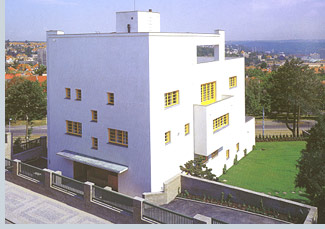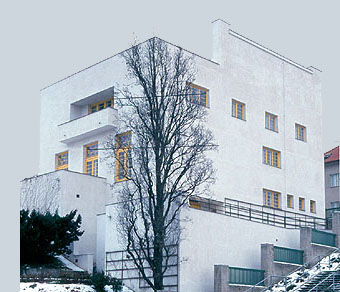

The Villa was built for himself and his wife Milada by the important Bohemian
construction entrepreneur Ing. Dr. František Müller. He was the
co-owner of the major Czech building firm Kapsa & Müller, founded in
Plzeň (Pilsen) in 1870 by his and his partner's fathers; the company
specialised in reinforced concrete industrial, transport and water-related
structures and public buildings, initially in Pilsen and later also in Prague,
Mladá Boleslav and elsewhere, and often employed new approaches to
construction and new technical methods. At the recommendation of the architect
Karel Lhota Dr. M?ller entrusted the design of the villa, with its major
representative function, to Adolf Loos, with whom Lhota had worked on several of
the latter's commissions in Pilsen. Given Loos' state of health, Lhota also
assisted in the realisation of this project, particularly in drawing up the
spatial design, as is attested by a surviving contract on clarifying the
co-authorship between Loos and Lhota.
Adolf Loos himself designed the interiors, including the light fittings, the
fitted and some of the non-fitted furniture. He himself said of the house that
it was his most beautiful, and spent his 60th birthday there in the company of a
close circle of friends. It was here that he was most perfectly able to embody
the ideas of his 'Raumplan'. The severity of the external facade, composed with
a refined balance in the asymmetric symmetry of the window apertures, contrasts
with the noble elegance of the interiors, even in the ostensibly secondary
spaces. The design of the garden was a collaboration between Loos and the German
landscape architects Camillo Schneider, Karl Fürster and Hermann Matern.
Nationalisation after 1948 had a decisive impact of the fate of M?ller family. A
critical period began in this history of Kapsa & Müller, and also in
that of the M?ller Villa, with - after the death of Frantiźek M?ller (1951)
- the desperate attempts of Milada Mülllerová and a range of leading
figures to save this important architectural monument. The widow was callously
confined to a small apartment within the Villa, and the other rooms became
offices for other users. The alterations which were carried out within the house
in this connection often caused unnecessary damage. On the hand, somewhat
paradoxically, the changes in use also led to the monument surviving in an
exceptionally well-preserved state.
After the fall of the Communist government the M?ller Villa was returned on the
basis of the restitution laws to its builder's daughter, Eva, who subsequently
offered it for sale. A media campaign began against the private sale of the Müller
Villa to a controversial financier. Thanks to the intervention of the City
Council, foreign activists and the local government in Prague 6, the Müller
Villa was eventually purchased by the City of Prague. In June 1995 it was then
placed under the care of the City of Prague Museum, and was subsequently
proclaimed a National Cultural Monument. An extensive reconstruction of the
Villa was undertaken in 1998-2000, and on May 24th 2000 the exposition and the
Adolf Loos Study and Documentation Centre were formally opened to the public.